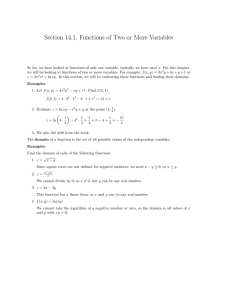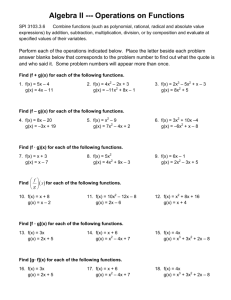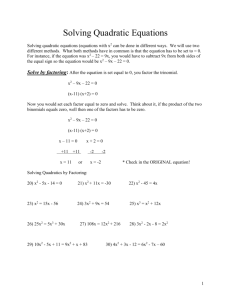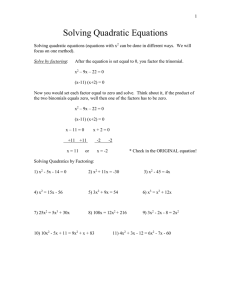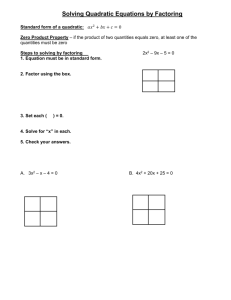Solving Quadratic Equations
advertisement
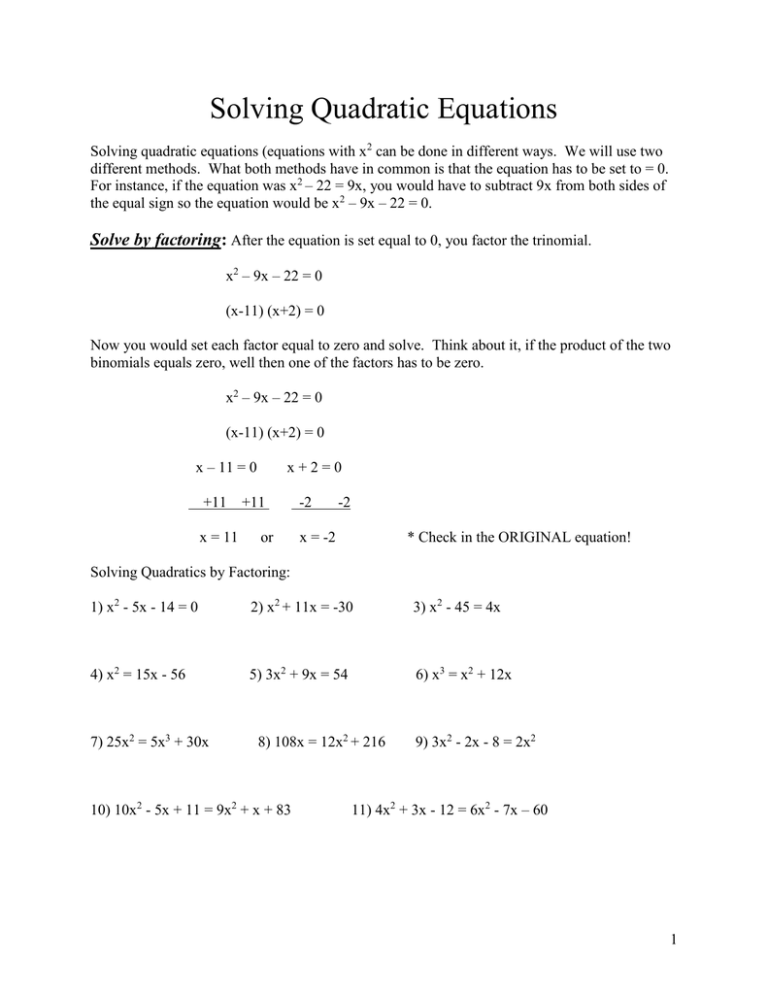
Solving Quadratic Equations
Solving quadratic equations (equations with x2 can be done in different ways. We will use two
different methods. What both methods have in common is that the equation has to be set to = 0.
For instance, if the equation was x2 – 22 = 9x, you would have to subtract 9x from both sides of
the equal sign so the equation would be x2 – 9x – 22 = 0.
Solve by factoring: After the equation is set equal to 0, you factor the trinomial.
x2 – 9x – 22 = 0
(x-11) (x+2) = 0
Now you would set each factor equal to zero and solve. Think about it, if the product of the two
binomials equals zero, well then one of the factors has to be zero.
x2 – 9x – 22 = 0
(x-11) (x+2) = 0
x – 11 = 0
x+2=0
+11 +11
-2
x = 11
x = -2
or
-2
* Check in the ORIGINAL equation!
Solving Quadratics by Factoring:
1) x2 - 5x - 14 = 0
2) x2 + 11x = -30
3) x2 - 45 = 4x
4) x2 = 15x - 56
5) 3x2 + 9x = 54
6) x3 = x2 + 12x
7) 25x2 = 5x3 + 30x
8) 108x = 12x2 + 216
10) 10x2 - 5x + 11 = 9x2 + x + 83
9) 3x2 - 2x - 8 = 2x2
11) 4x2 + 3x - 12 = 6x2 - 7x – 60
1
Solve each quadratic by factoring:
1) x2 – 3x – 108 = 0
2) x2 – 16x = - 55
3) x2 + 28 = 29x
4) x2 = x + 30
5) 6x2 = 54x – 120
6) x3 – 54x = 3x2
2
7) 7x2 + 14x = 560
8) 4x3 = -52x2 – 168x
9) 12x2 – 48x + 96 = 96
10) 15x3 – 28x = 105x2 – 28x
11) 4x2 – 96x = - 576
12) x2 – x = 5,256
3
Q3 Quiz 9 Review:
1) x2 – 14x = 15
2) x2 + 49 = -14x
3) 54 – 3x = x2
4) 8x2 + 192 = 88x
5) 2x3 + 30x2 + 112x = 0
6) 2x2 + 5x – 11 = 4x2 - 9x – 11
4
7) 3x2 – 11x + 31 = 7x2 – 11x – 33
8) 10x3 = 20x2 + 240x
9) x2 + 4x = 96
10) 7x6 + 35x5 = 350x4
11) 8x2 – 3x + 17 = 7x2 – 8x + 17
12) 5x2 – 4x – 13 = 4x2 + 3x + 17
Answer Key:
1) x = {-1,15}
5) x = {-8,-7,0}
9) x = {-12,8}
3) x = {-9,6}
7) x = {-4,4}
11) x = {-5,0}
2) x = {-7}
6) x = {0,7}
10) x = {-10,0,5}
4) x = {3,8}
8) x = {-4,0,6}
12) x = {-3,10}
5
Solve using the quadratic formula:
When ax2 + bx + c = 0
x=
-b ± √b2 – 4ac .
2a
a is the coefficient of x2 b is the coefficient of x c is the number (third term)
Notice the ±
is what will give your two answers (just like you had when solving by factoring)
x2 – 9x – 22 = 0
a=1
x=
-b ± √b2 – 4ac .
2a
b= - 9
c = -22
x=
-(-9) ± √ (-9)2 – 4(1)(-22)
2(1)
x=
9 ± √81 + 88
2
x=
9 ± √169 .
2
-4(1)(-22) = 88
Split and do the + side and - side
9 – 13
2
9 + 13
2
x = 11
or
x = -2
* Check in the ORIGINAL equation!
Solving Quadratics Using the Quadratic Formula:
31) 2x2 - 6x + 1 = 0
32) 3x2 + 2x = 3
33) 4x2 + 2 = -7x
34) 7x2 = 3x + 2
35) 3x2 + 6 = 5x
36) 9x - 3 = 4x2
6
WORD PROBLEMS WITH QUADRATICS
1) The area of a rectangle is 80 cm2. The width is stated as x + 3 and the length is stated as x +
14. Find the value of x and then use x to find the perimeter.
8) The area of a rectangle is 117 in2. The width is 4 less than the length. Find the perimeter
of the rectangle.
9) Find 5 negative consecutive integers such the product of the 2nd and the 5th is 504.
7
10) The area of a rectangle is 108 sq. feet. The length is 3 more than the width. Find the
perimeter. (must use let)
11) The area of a rectangle is 176 sq. feet. The width is 5 less than the length. Find the
perimeter. (must use let)
12) The area of a rectangle is 135 sq. feet. The length is 6 more than the width. Find the
perimeter. (must use let)
8
13) Find 5 positive consecutive integers such the product of the 1st and the 5th is 221.
14) Find 4 consecutive negative odd integers such that the product of the 2nd and 4th is 357.
9
Solving Perfect Squares
When the square root of a constant, variable or polynomial results in a constant the expression is a
perfect square. Some examples are 49, 64, and
.
Example:
Steps:
1.
1. Be sure that the binomial is fully isolated.
2. Take the square root of both sides.
3. Split the solution into two equations.
4. Solve both equations for x.
5. Create your final answer.
More Examples:
1)
2)
3)
4)
5)
6)
7)
8)
9)
10)
11)
12)
Completing the Square
10
Completing the square is another method that is used to solve quadratic equations. This method is
especially helpful when the quadratic equation cannot be solved by simply factoring.
***Remember the standard form for a quadratic equation is: ax2 + bx + c = 0.***
Example:
Steps:
1.
1. Be sure that the coefficient of the highest exponent
is 1. If it is not divide each term by that value to
create a leading coefficient of 1.
2. Move the constant term to the right hand side.
3. Prepare to add the needed value to create a perfect
square trinomial. Be sure to balance the equation.
4. To create the perfect square trinomial:
a) Take
b) Add that value to both sides of the equation.
5. Factor the perfect square trinomial.
6. Rewrite the factors as a squared binomial.
7. Take the square root of both sides.
8. Split the solution into two equations
9. Solve for x.
10. Create your final answer.
More Examples:
1)
2)
3)
4)
5)
6)
7)
8)
9)
10)
11)
12)
13)
14)
15)
16)
17)
18)
Solving Perfect Squares
11
1)
2)
3)
4)
5)
6)
7)
8)
9)
10)
11)
12)
Completing the Square
1)
2)
3)
4)
5)
6)
7)
8)
9)
10)
11)
12)
13)
14)
15)
16)
17)
18)
12
Proportions and Percents
Proportions:
A proportion is a statement that two ratios are equal. When trying to solve proportions we use
the Cross Products Property of Proportions.
A = C
A(D) = B(C)
B
D
Example:
6__ = x__
x + 5__ =
1.5___
11
121
12
6
6(121) = 11x
6(x + 5) = 12(1.5)
726 = 11x
6x + 30 = 18
-30
-30
6x
= -12
6
6
x
= -2
726 = 11x
11
11
66 = x
1)
x
14
_
=
16
35
2)
x–3 _ =
x+3
12
30
_
Percents:
Is
=
%___
Of
100
Example:
What number is 20% of 50?
Is:
?x
x
=
20 .
Of:
of 50
50
100
%:
20%
100: 100
100x = 20(50)
100x = 1,000
100x = 1,000
100
100
x = 10
a) What number is 40% of 160?
b) 48 is what percent of 128?
c) 28 is 75% of what number?
d) What number is 36% of 400?
13
Part I:
1)
x . =
12
18
54
.
2) -
13
x
. =
65
90
.
3) x + 4 . =
9
4) - 16 . =
8 .
6x-2
11
6) What is 20% of 32?
5)
14
. =
16
7) 72 is 40% of what number?
8) 21.56 is what percent of 98?
9) - 31 is what percent of -124?
6x .
18
3x
.
3x + 3
10) What is 62% of 140?
Part II:
1)
x . =
12
13
78
4)
- 16 . =
5x-2
8 .
11
.
2)
- 13
x
5)
x+5
x-3
. =
195
150
. =
x
9
.
.
3) x + 4 . =
9
6x .
18
6)
9 _
x+8
x-4 _ =
12
7) 12 is 40% of what number?
8) 21.56 is what percent of 98?
9) 45 is what percent of 180?
10) What is 62% of 70?
Part III:
1)
23
x
4)
x+1
x+6
.
=
.
57.5
45
=
.
2
x
.
2) 3x – 5 . =
13
5x + 1 .
52
5) 2x – 4 . =
x+5
x-2 .
x+1
10) What is 80% of 850?
8) 128 is 32% of what number?
9) 72 is what percent of 120?
10) What is 80% of 850?
3) 5x -1
10x+5
6) x + 7
2x – 1
= 33 .
45
= x+6 .
x-2
14
Mixed Equations: Figure out what type of equation you have and then pick a strategy
to solve.
1) 20 - (5/8)x = 40
2) 6(7x - 2) = 8(4x + 1)
3) 2(5x - 4) - 3(4x + 3) = -43
4) x2 + 44 = 15x
5) 3x2 + 18x = 81
6) 3x2 = 5x + 5
7) 11x - 5 = 7x - 53
8) 6(3x + 1) + 5(10 - 4x)= 39
9) ¼x - 33 = -49
10) 7x2 - 1 = 3x
11) 9(3x + 1) = 8(5x + 6)
12) 15x = x2 – 16
13) x2 + 8x = 12
14) 9(4x + 7) - 6(7x + 10) = -54
15) 44 = 20 - 2x
16) 4x2 - 128 = 16x
17) 3x2 - 8x + 6 = x + 6
18) 7(6x + 2) = 10(3x + 5)
19) 3x2 + 13x - 12 = 9x2 - 11x - 12
21)
24)
14 . =
8x - 4
10 . =
7x + 2
35
50
8 .
5x + 4
.
22)
25)
20) 2x2 - 14 = 10x
x+5
x-4
. =
x-6
. =
2x - 3
x
32
.
x + 12 .
x+4
23) x - 10_ =
12
6 _
x-4
26) 2x - 3 =
x+1
x-3 _
x+3
15
